 On a recent Sunday afternoon, I sat down with William Salit in his brand-new studio at ARC, the gallery/studios complex that my partners and I recently started in SOMA. We talked about setting up his new space – his first studio since the tragic demise of Belcher Studios two years ago. Belcher Studios was, in many ways, the template that we used when we started ARC. We all loved the energy and spirit of community at Belcher. In fact, when I first found out that the building that used to house New Langton Arts was available, I actually approached some of the former Belcher artists about the possibility of resurrecting that community in the building. Ultimately that did not work out. We formed our own partnership and started ARC. However, I was really thrilled when William, one of the Belcher artists that I really admired, decided to join the studios.
On a recent Sunday afternoon, I sat down with William Salit in his brand-new studio at ARC, the gallery/studios complex that my partners and I recently started in SOMA. We talked about setting up his new space – his first studio since the tragic demise of Belcher Studios two years ago. Belcher Studios was, in many ways, the template that we used when we started ARC. We all loved the energy and spirit of community at Belcher. In fact, when I first found out that the building that used to house New Langton Arts was available, I actually approached some of the former Belcher artists about the possibility of resurrecting that community in the building. Ultimately that did not work out. We formed our own partnership and started ARC. However, I was really thrilled when William, one of the Belcher artists that I really admired, decided to join the studios.
At Belcher, the first studio that you encountered when you entered was William Salit’s studio. When William saw the studio at the top of the stairs with its window open to the staircase, it was like coming home. He immediately took the space. In February, he started moving in. By last week’s grand opening, it was beautifully laid out. All of which led to a conversation about the importance of place.
Over the past two years, he has largely taken a hiatus from drawing. As you can tell from his beautifully organized studio, William has a love affair with order. Everything has a place and everything is in its space. This is true in his home, his office and his studio. However, strangely enough, he found that this need for order in most of his life was stifling his art. He was not able to “let go” in his ordered spaces. At Belcher, he had given himself the freedom to allow chaos into his studio. He is not quite there yet at ARC. But, he envisions very shortly carving out an island of chaos where he can have the freedom to let his art take him wherever it wants to go.
There is an echo of Greek mythology in this discussion. Chaos was the primordial ether from which the gods created the universe. It was not the opposite of order. Rather it was the raw material from which order was drawn. For William, the physical connection between chaos and order is his crayon. He talks about his hand and the graphite in that hand as if it was somehow disconnected from his body: “My hand loves a piece of the Conté crayon in it.” He draws aggressively. It is not a delicate process. This is no gentle foxtrot. It is a wild tango. And, the Conté crayon is a very hard kaolin/graphite/pigment mixture that accommodates his dance. 
The range of William’s work is astonishing. I asked him to pull out some of his work , so we could talk a little bit about some of the different things that he had done and that he was doing. We actually started with a recent series of photographs. When he was without a dedicated studio, his drawing almost completely stopped. No island of chaos was available. His design work benefited, as his art sought an outlet. He also began photographing more seriously. I was particularly drawn to a large series of works of “found objects” photographed in the streets of San Francisco. They are unstaged objects found lying on the street that do not belong. I was particularly fascinated with the Band-Aid meticulously affixed along side a crack in the sidewalk.
 There are the “Old Master” drawings – studies of the head and the figure reminiscent of Italian Renaissance drawings. He opened his flat file and pulled out study after study of Val, his continuous muse for over 20 years – going back to his college days in New York. They moved to San Francisco together. He has drawn her literally thousands of times. I, in fact, met her leaving William’s studio when I arrived. These are masterful, traditional drawings. They are beautiful in their own right. But, they are also like a musician playing his scales. As William gears up, the drawings are his way of stretching his artistic muscles.
There are the “Old Master” drawings – studies of the head and the figure reminiscent of Italian Renaissance drawings. He opened his flat file and pulled out study after study of Val, his continuous muse for over 20 years – going back to his college days in New York. They moved to San Francisco together. He has drawn her literally thousands of times. I, in fact, met her leaving William’s studio when I arrived. These are masterful, traditional drawings. They are beautiful in their own right. But, they are also like a musician playing his scales. As William gears up, the drawings are his way of stretching his artistic muscles.
And, last but not least, we talked about the organic abstractions. The foundation here is also the figure. However, it is a sub-conscious foundation. He begins with a line and starts drawing without purpose. As it takes shape,  he might turn it sideways or upside-down to make sense out of it. He adds oil washes to the waxy charcoal. He collages on the drawing. He colors on the drawing. In some cases, he makes a series of prints utilizing techniques similar to monoprinting. I asked him how he knew he was done. He described a process of “half lives”. The frenzy simply winds down. It is never really done. But, much like a calculation in calculus, the drawing simply approaches being finished to the point where there was no meaningful difference between being finished and being almost finished. Then he stops.
he might turn it sideways or upside-down to make sense out of it. He adds oil washes to the waxy charcoal. He collages on the drawing. He colors on the drawing. In some cases, he makes a series of prints utilizing techniques similar to monoprinting. I asked him how he knew he was done. He described a process of “half lives”. The frenzy simply winds down. It is never really done. But, much like a calculation in calculus, the drawing simply approaches being finished to the point where there was no meaningful difference between being finished and being almost finished. Then he stops.
William Salit is one of the featured artists on this month’s Tour des Artistes studio tours. You can also see his work at the SOMA Spring Open Studios. There will be a preview exhibition at ARC Gallery on April 9-10. And, his studio will be open for Open Studios on April 16-18. Or, you can contact William through his website to arrange to for a studio visit by appointment.
Filed under: Artist Profile, SOMA Open Studios, Spring Open Studios, Tour des Artistes, William Salit | 4 Comments »




 San Francisco Open Studios kicks off every year with a celebratory party previewing many of the works that will be shown over the month of October and into November, as over 800 artists open their studios. One of the recent traditions has been to have many of those artists paint wine glasses as gifts of appreciation for the fellow artists, art collectors and patrons who attend the Private Preview party. For a number of years, my wife and I sought out the glasses painted by
San Francisco Open Studios kicks off every year with a celebratory party previewing many of the works that will be shown over the month of October and into November, as over 800 artists open their studios. One of the recent traditions has been to have many of those artists paint wine glasses as gifts of appreciation for the fellow artists, art collectors and patrons who attend the Private Preview party. For a number of years, my wife and I sought out the glasses painted by  quest for knowledge – knowledge which can be both a boon, but also perilous. They stand at the gateway between this world and the after-world; they are healer, but not entirely trust-worthy; they are creator and trickster. It is that duality that has drawn Zannah to them. One or two in a painting, and they are waiting and watching. They are about possibilities. Put them all in a line, and they are gatekeepers waiting to take you to the other side. They are about transformation. Repeating these images into the picture frame is a way for Zannah to tell a story, but not in a linear way. Why birds? It is because, for Zannah, the ravens and crows tie together many avenues of exploration.
quest for knowledge – knowledge which can be both a boon, but also perilous. They stand at the gateway between this world and the after-world; they are healer, but not entirely trust-worthy; they are creator and trickster. It is that duality that has drawn Zannah to them. One or two in a painting, and they are waiting and watching. They are about possibilities. Put them all in a line, and they are gatekeepers waiting to take you to the other side. They are about transformation. Repeating these images into the picture frame is a way for Zannah to tell a story, but not in a linear way. Why birds? It is because, for Zannah, the ravens and crows tie together many avenues of exploration. It is interesting to look at the work of some of the artists that she lists as influences. There is the brilliant graphic novelist Bill Sienkiewicz. His seminal work, Stray Toasters, is a crime thriller with a protagonist, “Magik” who is either a wrong-accused, unfairly incarcerated hero, or possibly an untrustworthy narrator – you be the judge. She pulled out a powerful image of “Woman with Dead Child” by Kathe Kollwitz. This German illustrator/printmaker spent a lifetime chronicling injustice in the world around her. She studied under Carrie Mae Weems, at the University of Massachusetts. The works in series by this distinguished photographer explore
It is interesting to look at the work of some of the artists that she lists as influences. There is the brilliant graphic novelist Bill Sienkiewicz. His seminal work, Stray Toasters, is a crime thriller with a protagonist, “Magik” who is either a wrong-accused, unfairly incarcerated hero, or possibly an untrustworthy narrator – you be the judge. She pulled out a powerful image of “Woman with Dead Child” by Kathe Kollwitz. This German illustrator/printmaker spent a lifetime chronicling injustice in the world around her. She studied under Carrie Mae Weems, at the University of Massachusetts. The works in series by this distinguished photographer explore racism and gender issues and bravely challenge the establishment. And then she throws in Bansky, the infamous graffiti artist, whose work is both politically-charged, but also tongue in cheek. Clearly Zannah is a little bit complicated. With the Crow, she seems to have found a perfect avatar. I know that for me, drinking champagne from flutes encircled by crows on glass branches will always be a little more thought-provoking from now on.
racism and gender issues and bravely challenge the establishment. And then she throws in Bansky, the infamous graffiti artist, whose work is both politically-charged, but also tongue in cheek. Clearly Zannah is a little bit complicated. With the Crow, she seems to have found a perfect avatar. I know that for me, drinking champagne from flutes encircled by crows on glass branches will always be a little more thought-provoking from now on.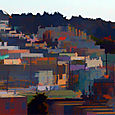 Mitchell attended college in Fullerton where he received a degree in Printing. He then went on to formally study art at the Arts Center College of Design in Pasadena. For the past 20 years, he has worked as a commercial illustrator, photographer, artist and teacher. The marriage of art and technology in his work is no accident. It was almost pre-destined. His mother was an artist. His father was an engineer. He is the resolution of his left and right brain mixed heritage.
Mitchell attended college in Fullerton where he received a degree in Printing. He then went on to formally study art at the Arts Center College of Design in Pasadena. For the past 20 years, he has worked as a commercial illustrator, photographer, artist and teacher. The marriage of art and technology in his work is no accident. It was almost pre-destined. His mother was an artist. His father was an engineer. He is the resolution of his left and right brain mixed heritage.  technology are not very transparent about it. They seem to feel a little bit guilty that it was not all created with traditional drawing and painting techniques. He is, on the other hand, unapologetic. He fully embraces digital technology, which he combines much of the time with drawing, painting and photography. For him, it is about “solving the problem”. He talks about “happy accidents” – starting with an idea, exploring that idea, but also allowing “process” to take him in unexpected directions. Because he has both an art and a technical background, he is constantly forging new ground in what is possible, particularly with his innovative printing techniques. Watching him print multiple layers on a wood veneer is a really eye-opening experience.
technology are not very transparent about it. They seem to feel a little bit guilty that it was not all created with traditional drawing and painting techniques. He is, on the other hand, unapologetic. He fully embraces digital technology, which he combines much of the time with drawing, painting and photography. For him, it is about “solving the problem”. He talks about “happy accidents” – starting with an idea, exploring that idea, but also allowing “process” to take him in unexpected directions. Because he has both an art and a technical background, he is constantly forging new ground in what is possible, particularly with his innovative printing techniques. Watching him print multiple layers on a wood veneer is a really eye-opening experience.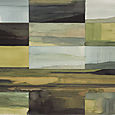 at Cezanne gave us and finding new ways to use that vocabulary. Cezanne intensely studied his subjects, more often than not landscapes. He deconstructed the subjects and then reassembled them into planes of color. You cannot help but to see that continuing conversation in Confer’s work. He has a real sense of design, combined with a truly deft touch with an unconstrained color palette. And, with almost missionary zeal, he is embracing modern technology and incorporating that into the conversation, as well.
at Cezanne gave us and finding new ways to use that vocabulary. Cezanne intensely studied his subjects, more often than not landscapes. He deconstructed the subjects and then reassembled them into planes of color. You cannot help but to see that continuing conversation in Confer’s work. He has a real sense of design, combined with a truly deft touch with an unconstrained color palette. And, with almost missionary zeal, he is embracing modern technology and incorporating that into the conversation, as well. 
 For Robin, painting has always been a part of his life. Like most artists, he worked in a variety of jobs after college that allowed him to continue to paint. He attributes a lot of his current success to his participation in Open Studios. That is where he had his first real success selling his work to the general public. That is where his work was discovered, leading to early representation at galleries in Palo Alto. And, that is where he continues to show and sell his paintings even now. He has focused on his encaustic landscapes for the past ten years, creating a highly identifiable, unmistakable style. When opportunity knocked, he was ready. His commitment to his craft was palpable.
For Robin, painting has always been a part of his life. Like most artists, he worked in a variety of jobs after college that allowed him to continue to paint. He attributes a lot of his current success to his participation in Open Studios. That is where he had his first real success selling his work to the general public. That is where his work was discovered, leading to early representation at galleries in Palo Alto. And, that is where he continues to show and sell his paintings even now. He has focused on his encaustic landscapes for the past ten years, creating a highly identifiable, unmistakable style. When opportunity knocked, he was ready. His commitment to his craft was palpable.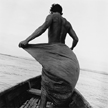
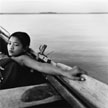
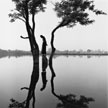
 discovery, leading to gallery representation came from taking every opportunity to exhibit in group shows; participate in artistic critiques, and join professional organizations.
discovery, leading to gallery representation came from taking every opportunity to exhibit in group shows; participate in artistic critiques, and join professional organizations. the Building Manager’s office (appropriately enough, that would be Pico, who is also the ten-time President of Artaud), your senses are immediately assaulted by a joyous cacophony of color and shape. The courtyard is Pico’s playground. Pico has been a fixture here for twenty-five years; moving here from Wisconsin and living in the parking lot for three years while waiting for a studio to open. It was and is the place where he was always meant to be.
the Building Manager’s office (appropriately enough, that would be Pico, who is also the ten-time President of Artaud), your senses are immediately assaulted by a joyous cacophony of color and shape. The courtyard is Pico’s playground. Pico has been a fixture here for twenty-five years; moving here from Wisconsin and living in the parking lot for three years while waiting for a studio to open. It was and is the place where he was always meant to be. From as far back as he can remember, Pico has always been mesmerized by the colors, shapes and shadows surrounding him. He grew up in Mexico City and many from his mother’s side of the family were artists in one way or another. There were constant gatherings filled with music and art. There were also a few oil paintings hanging on the wall in his house that had been purchased in Europe. As Pico described them, it was almost as if he was looking at them at that moment: sunset in the coliseum in Rome; a caravan of camels in the desert – these were the original images that captured his imagination.
From as far back as he can remember, Pico has always been mesmerized by the colors, shapes and shadows surrounding him. He grew up in Mexico City and many from his mother’s side of the family were artists in one way or another. There were constant gatherings filled with music and art. There were also a few oil paintings hanging on the wall in his house that had been purchased in Europe. As Pico described them, it was almost as if he was looking at them at that moment: sunset in the coliseum in Rome; a caravan of camels in the desert – these were the original images that captured his imagination. 
